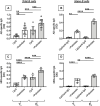Obesity Accelerates Age-Associated Defects in Human B Cells Through a Metabolic Reprogramming Induced by the Fatty Acid Palmitate
- PMID: 35822047
- PMCID: PMC9261304
- DOI: 10.3389/fragi.2021.828697
Obesity Accelerates Age-Associated Defects in Human B Cells Through a Metabolic Reprogramming Induced by the Fatty Acid Palmitate
Abstract
We have measured the secretion of autoimmune antibodies in plasma samples and in culture supernatants of blood-derived B cells from four groups of individuals: young lean (YL), elderly lean (EL), young obese (YO) and elderly obese (EO). We found secretion comparable in YO and EL individuals, suggesting that obesity accelerates age-associated defects in circulating B cells. To define at least one possible molecular pathway involved, we used an in vitro model in which B cells from YL and EL individuals have been stimulated with the Fatty Acid (FA) palmitate, the most common saturated FA in the human body. The rationale to use palmitate is that there is a chronic increase in circulating levels of palmitate, due to increased spontaneous lipolysis occurring during aging and obesity, and this may induce autoimmune B cells. Results herein show that in vitro incubation of B cells from YL and EL individuals with the FA palmitate induces mRNA expression of T-bet, the transcription factor for autoimmune antibodies, as well as secretion of autoimmune IgG antibodies, with B cells from YL individuals looking similar to B cells from EL individuals, confirming our initial hypothesis. The generation of autoimmune B cells in the presence of the FA palmitate was found to be associated with a metabolic reprogramming of B cells from both YL and EL individuals. These results altogether show the critical role of the FA palmitate in inducing human B cell immunosenescence and show for the first time the importance of metabolic pathways in this process.
Keywords: B cells; aging; autoimmunity; metabolism; obesity.
Copyright © 2022 Frasca, Romero, Garcia, Diaz and Blomberg.
Conflict of interest statement
The authors declare that the research was conducted in the absence of any commercial or financial relationships that could be construed as a potential conflict of interest.
Figures






Similar articles
-
Obesity accelerates age defects in B cells, and weight loss improves B cell function.Immun Ageing. 2023 Jul 17;20(1):35. doi: 10.1186/s12979-023-00361-9. Immun Ageing. 2023. PMID: 37460937 Free PMC article.
-
Palmitate-Induced MMP-9 Expression in the Human Monocytic Cells is Mediated through the TLR4-MyD88 Dependent Mechanism.Cell Physiol Biochem. 2016;39(3):889-900. doi: 10.1159/000447798. Epub 2016 Aug 9. Cell Physiol Biochem. 2016. PMID: 27497609
-
Metabolic requirements of human pro-inflammatory B cells in aging and obesity.PLoS One. 2019 Jul 9;14(7):e0219545. doi: 10.1371/journal.pone.0219545. eCollection 2019. PLoS One. 2019. PMID: 31287846 Free PMC article.
-
Obesity Accelerates Age Defects in Mouse and Human B Cells.Front Immunol. 2020 Sep 2;11:2060. doi: 10.3389/fimmu.2020.02060. eCollection 2020. Front Immunol. 2020. PMID: 32983154 Free PMC article. Review.
-
The Influence of Obesity and Associated Fatty Acids on Placental Inflammation.Clin Ther. 2021 Feb;43(2):265-278. doi: 10.1016/j.clinthera.2020.12.018. Epub 2021 Jan 21. Clin Ther. 2021. PMID: 33487441 Free PMC article. Review.
Cited by
-
Phenotypic and functional features of B cells from two different human subcutaneous adipose depots.PLoS One. 2023 Apr 27;18(4):e0285025. doi: 10.1371/journal.pone.0285025. eCollection 2023. PLoS One. 2023. PMID: 37104286 Free PMC article.
-
The 'omics of obesity in B-cell acute lymphoblastic leukemia.J Natl Cancer Inst Monogr. 2023 May 4;2023(61):12-29. doi: 10.1093/jncimonographs/lgad014. J Natl Cancer Inst Monogr. 2023. PMID: 37139973 Free PMC article.
-
Gerotherapeutics: aging mechanism-based pharmaceutical and behavioral interventions to reduce cancer racial and ethnic disparities.J Natl Cancer Inst. 2025 Mar 1;117(3):406-422. doi: 10.1093/jnci/djae211. J Natl Cancer Inst. 2025. PMID: 39196709 Free PMC article. Review.
-
The effect of intermittent fasting on preventing obesity-related early aging from a molecular and cellular perspective.J Med Life. 2024 Mar;17(3):261-272. doi: 10.25122/jml-2023-0370. J Med Life. 2024. PMID: 39044934 Free PMC article. Review.
-
T cells in obesity-associated inflammation: The devil is in the details.Immunol Rev. 2024 Jul;324(1):25-41. doi: 10.1111/imr.13354. Epub 2024 May 20. Immunol Rev. 2024. PMID: 38767210 Free PMC article. Review.
References
LinkOut - more resources
Full Text Sources

